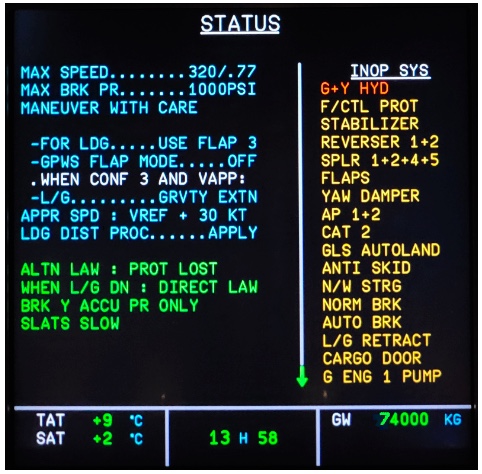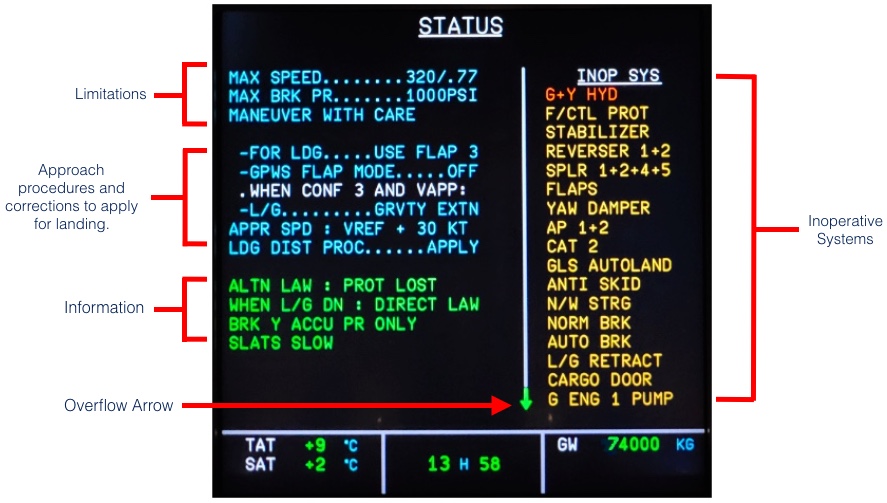Real pros know how to extract information from the STATUS page.
Welcome to the first part of a two-lesson set designed to help you uncover and extract the most valuable information hidden away within the STATUS page.
Part One illustrates a quick but surefire method to extract the most important operational points from the STATUS.
This will suffice for most failure cases and help you to process, clarify and share information with your crew.
Part Two goes deeper and will show you how to derive and understand the implied meaning from the STATUS.
This is a crucial point and one that many new players miss.
But not you, Insider, because in Part 2, I’m even going to show you how to organise these important points into a complete operational plan.
This process is likely something that no one has ever shown you before, which is not only unfortunate but is robbing you of valuable information and operational delight.
But not to worry, Mate, because I’m going to break it down for you.
The bottom line is that if you’re not using the STATUS to help you to understand, generate and execute the plan, then you’re missing the point of the whole bloody thing!
See, execution becomes mission-critical when dealing with complex failures like EMER ELEC and DUAL HYD Failure cases.
This information that follows has been taken directly from Checkmate, our complete course on Emergency Management in the A320, which will show you just how to think and fly your way through any emergency situation in the A320.
If you’re like most pilots, your emergency management skills could stand some improvement.
So, if you find anything here even remotely useful, then you’ll find Checkmate to be a complete lifesaver.
You can find complete details and drastically improve your ability to operate the Airbus by clicking here.
Let’s dig in…
STATUS IS IMPORTANT!
Let me begin with a short rant.
When you’re new to something, there’s so much that you just don’t know and can’t see yet.
Scientists call this unconscious incompetence, and it basically means you don’t even know what you don’t know.
Often, this phenomenon causes people (and pilots) to pretend that they know more than they do in order to compensate for all that they don’t.
Try bluffing your way through a conversation about geopolitics with someone from a think tank, and you’re likely to get caught out pretty quickly.
Luckily, all that will be bruised is your ego.
Try bluffing your way through a problem in the Airbus, and your injuries could be a bit more severe.
The point I’m trying to make is that when flying an aeroplane, you must, at all times, respect the fact that you probably don’t know everything.
And when you bump into one of those things you don’t know, it’s best to have a “beginner’s mindset,” in order to be open to all available knowledge.
By accepting your lack of understanding when learning something new, you can actually put yourself in a better position to be more open to new ideas.
Rant over.
When dealing with the STATUS page, it’s important to be open-minded.
See, during complex failure cases, it’s often not so much what the STATUS page says that’s important but what it implies.
Let’s take a look at the STATUS page using a HYD G +Y LO PR as an example.
I’d like you to look at the STATUS page above and quickly jot down the things you might mention to your PM during an approach briefing if you had this failure in real life.
Go ahead, this is how learning works.
I’m serious…go get a sheet of paper, and write down what you would mention.
I’ll wait for you here.
Let’s talk a bit about the STATUS page because it’s by getting a feel for the overall philosophy of the thing, we can better understand how to use it correctly.
During the course of most emergencies in the Airbus A320, you will, at some point, have to deal with the STATUS page.
For most crews, the STATUS page is seen as a necessary evil, something they need to get through whilst on their way to something else.
However, the purpose of the STATUS page is to assist you by displaying a wealth of valuable information, such as:
- Limitations to respect.
- Inoperative systems.
- Procedures to apply.
- Systems to configure.
Think LIPS!
A quick review of the STATUS page’s layout can help us to better understand what we’re looking at.
See the STATUS page has been designed to show you the aircraft’s status!
Let’s assume that you’ve already looked at the STATUS page during the initial processing of the ECAM and are now actively preparing for the approach.
With a crappy layout and a surplus of information barfed onto the screen, the STATUS page can be a bloody hassle to get through.
The truth is most pilots find it cluttered, confusing, and unclear.
It’s precisely what you don’t want to deal with while in the middle of an emergency.
This simple fact causes most pilots to rush through it on their way to the other stuff, neither developing nor sharing a complete understanding of what’s on the page.
But if you know what to look for and how to look at it, the STATUS page can help you to understand the aircraft’s current situation better.
What’s needed is a more deliberate, step-by-step manner to process the information presented to us.
Let me show you how a professional looks at the STATUS page.
Once you spend enough time on the Airbus, you’ll come to understand that not everything on the STATUS page is of equal importance.
What you need is a quick way to extract the most important stuff.
And guess what?
I’ve got one.
FROG BAC
FROG BAC is a simple acronym to help you extract the most critical information from the STATUS page.
Each letter stands for a particular system and helps you squeeze the STATUS for its most useful information.
FROG BAC helps you stay focused on the big picture and prevents you from getting bogged down in unnecessary detail.
It’s easy to use too.
Simply say the mnemonic to yourself and consider how each item will affect your operation.

Ready for your next Checkride?
Probably not as ready as you should be.
Certainly not as ready as you could be.
Click here to find out more about the world’s first and finest, complete emergency management system designed especially for the A320.
Each item within FROG BAC has its own set of considerations, guiding you to ask the right questions, so you’ll be able to generate a better idea of the aircraft’s state.
Remember, in an ideal world, you’d go through the STATUS page 2-3 times.
If that sounds crazy, just hear me out.
The first time through the STATUS page is, for all practical purposes, just a box-ticking exercise.
You’ve got other stuff to deal with and during that first time through, you’re just trying to get a quick idea of what the aircraft’s state is.
However, later, as you prepare for the approach, you’ll return to the STATUS, and at this time, your reading of it should be a bit more thoughtful, a bit more thorough.
It’s at this point that FROG BAC can help you to see what’s really important.
As you go through the acronym, check each system and determine its operational state.
For instance:
- Is the system working properly?
- If not, what are we left with?
The third time you’ll go through the STATUS is during the actual briefing in order to further develop the crew’s shared mental model.
Using FROG BAC in this manner can help you to quickly identify, understand and share items of operational concern without getting lost in the weeds.
FROG BAC Quick questions:
Here’s a smattering of surface-level questions to help you extract information from the relevant systems.
F: Flight Controls
- What Control Law is active?
R: Reverse
- Is reverse thrust available on both engines, one engine or no engines?
O: Overweight
- Is the Aircraft Overweight?
G: Gear
- Is gear extension normal or gravity?
- Is gear retraction normal or will it be stuck down?
B: Braking
- What type of braking will we have?
A: Automatics
- What automatics are available?
- What is the Approach Capability of the aircraft?
C: CONFIG
- What is the flap lever position for landing?
- What is the operational status of the flaps and slats?
While there’s a lot of information here, it’s rare that you’ll need to use it all because it’s unlikely that all of these systems will be affected at the same time.
However, it’s crucially important to know how to cope should you find yourself in just such a case.
Let me show you how.

In the example above, the aircraft has suffered a failure of the Green and Yellow Hydraulic systems.
This is a pretty serious event in the A320 and as you can see there’s a lot of junk on the STATUS.
When ready to dive into the STATUS, we can use FROG BAC to focus our understanding.
This is a godsend when in a time-critical situation and if we’re in a real hurry, FROG BAC can help us quickly run through the operational staus of the aircraft:
Here’s what it might sound like if I were to go through FROG BAC quickly.
“Alternate Law, no protections. Stab inop, only Spoiler 3 available.”
“No Reverse”
“We’re overweight. Overweight Landing Checklist is required.”
“Gravity gear extension. DIR Law at gear down. No gear retraction. No nosewheel steering.”
“MAX BRK Pressure is 1000 psi. Braking is on Y accumulator only. No antiskid, no normal brakes, no autobrake.”
“Autopilot Inop, we need CAT 1 or better. No GLS Autoland.”
“Flap Lever 3 for landing. Slats only and they will be slow. No flaps.”
Keep in mind that all we’ve really done here is identify the status of the various systems.
This sort of quick review will suffice for most types of failures.
However, more complicated failures will require a bit more consideration and to better understand these, please read Part 2 of this lesson, after you’re finished here.
But don’t worry because I cover this thoroughly in Part 2 of this lesson.
I’ve purposely limited the depth and scope of my explanations here, since this is Part 1, and at this point, my priority was to show you a general method to determine just what information is critical and how to extract it.
In Part 2, I’ll show you how to decode this information and shape it into an easy to use operational plan.
Did I mention that Part 2 is a paid lesson?
Sorry Mate, I’ve got to bloody eat too!
In any case it’s cheap, about the price of a beer at the Hotel Bar.
Just think…you could buy the guy you’re flying with a beer at the Hotel Bar and all you’d learn about was his crappy flying schedule.
Or, you could buy me a beer at the Hotel Bar and I’ll tell you everything I know about how to use the STATUS page to help you make better decisions!
Seems like a fucking no-brainer Mate!
Anyway, I digress…back to the lesson!
Here’s how I recommend that you use FROG BAC.
- First, during the initial STATUS review, use FROG BAC to quickly and silently raise your awareness of each of these items. It’s especially useful to understand and confirm the landing capability of the aircraft (CAT I, II, or III).
- Second, during your actual approach preparation or briefing bring up the STATUS page and quickly go through FROG BAC with the crew, highlighting these most critical elements.
- Third, generate a three-dimensional plan. While the STATUS tells you what’s wrong, it doesn’t always clearly reveal how this will impact the approach and landing. You need to be able to figure this part out so everyone knows what, when and how things are going to be accomplished. See Getting the Most From the STATUS Page: Part 2, to learn how to do this.
Looking at these three, I consider the first to be optional but valuable.
I consider the second to be mandatory.
The third is the mark of the well-seasoned professional with a polished operation.
As they say in Thailand…”Up to you.”
So there you have it Mate, a first look at just what you should be thinking about when looking at the STATUS page in the A320.
While a lot of this may seem as obvious as dog’s balls, keep in mind that understanding just how to use the STATUS can be difficult, especially if you’ve never been taught how to use it properly.
In my experience, it’s yet another area that isn’t correctly illuminated by Airbus leaving it poorly understood and under-appreciated by most pilots.
Anyway, I hope that this training put some new tools in your kit and maybe even helped you to harness a new way of thinking and seeing.
FROG BAC can help you to extract the truly essential information, and do so quickly, clearly and consistently.
For the record, there are a number of other mnemonics that work just as well, so find one that works for you and use it.
And while going through the STATUS page in this way can seem a bit clunky at first, the more you use it, the better it gets.
This means you’ll be able to better organise your thoughts, which makes the creation and sharing of a correct mental model, easier, more natural and most importantly, more likely to happen.
But don’t stop here!
Be sure to check out “Getting the Most from the STATUS Page – Part 2” to take your understanding to the next level.
It’s cheap, delicious, nutritious and helps to support the entire A320 Insider operation!
Be kind, be smart, fly well.
Until next time…





